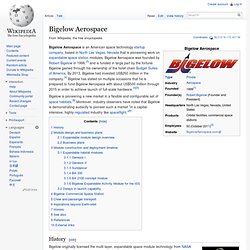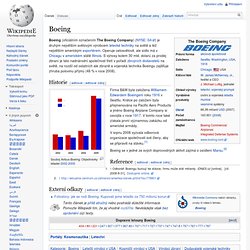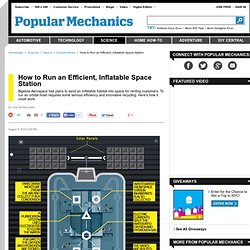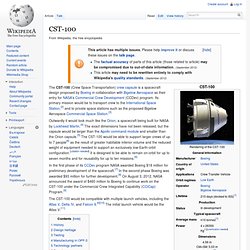Zoom
Trash

Bigelow Aerospace. Bigelow Aerospace. Bigelow Aerospace is an American space technology startup company, based in North Las Vegas, Nevada that is pioneering work on expandable space station modules.

Bigelow Aerospace was founded by Robert Bigelow in 1998.[3] and is funded in large part by the fortune Bigelow gained through his ownership of the hotel chain Budget Suites of America. By 2013, Bigelow had invested US$250 million in the company.[4] Bigelow has stated on multiple occasions that he is prepared to fund Bigelow Aerospace with about US$500 million through 2015 in order to achieve launch of full-scale hardware.[3][5] Bigelow is pioneering a new market in a flexible and configurable set of space habitats.[6] Moreover, industry observers have noted that Bigelow is demonstrating audacity to pioneer such a market "in a capital-intensive, highly-regulated industry like spaceflight.
"[6] History[edit] NASA's TransHab Design Module design and business plans[edit] Expandable module design overview[edit] Business plans[edit] The Boeing Company. Boeing. Boeing (oficiálním označením The Boeing Company) (NYSE: BA) je druhým největším světovým výrobcem letecké techniky na světě a též největším americkým exportérem.

Operuje celosvětově, ale sídlo má v Chicagu v americkém státě Illinois. S výnosy kolem 30 mld. dolarů za prodej zbraní je tato nadnárodní společnost třetí v pořadí zbrojních dodavatelů na světě, na rozdíl od ostatních ale zbraně a vojenská technika Boeingu zajišťuje zhruba polovinu příjmů (48 % v roce 2008). Historie[editovat | editovat zdroj] Souboj Airbus-Boeing: Objednávky letadel 2002-2005 Firma B&W byla založena Williamem Edwardem Boeingem roku 1916 v Seattlu. V srpnu 2008 vyzvala odborová organizace společnosti své členy, aby se připravili na stávku.[1] Boeing se v jedné ze svých doprovodných aktivit zajímá o osídlení Marsu.[2] Reference[editovat | editovat zdroj] Externí odkazy[editovat | editovat zdroj] Fotostory: jak se rodí Boeing.
Inflatable Orbital Space Habitat – Bigelow Aerospace Habitat. August 5, 2010 2:00 PM (Illustration by Leandro Castelao) To maximize efficiency, everything inside a space station should be reused, including the sweat, urine and wastewater of its inhabitants.

Las Vegas–based Bigelow Aerospace—which is currently building inflatable, orbital habitats to rent to customers—will be recycling these fluids to power the station’s thrusters. The system, designed by Orion Propulsion (now owned by Dynetics), collects and purifies the wastewater before using an electric current to break it into hydrogen and oxygen. The thrusters ignite the gases to provide force that keeps the station stable and correctly positioned in orbit. The space station operators have good reason for replacing propellants such as hydrazine or nitrogen tetroxide with water collected from a life-support system: money.
Bigelow already launched two prototypes into orbit, but won’t light a vacancy sign until private space companies create the craft that will deliver customers. Inflatable Private Space Station/Hotel - Bigelow Aerospace. CST-100. The CST-100 (Crew Space Transportation) crew capsule is a spacecraft design proposed by Boeing in collaboration with Bigelow Aerospace as their entry for NASA's Commercial Crew Development (CCDev) program.

Its primary mission would be to transport crew to the International Space Station,[2] and to private space stations such as the proposed Bigelow Aerospace Commercial Space Station.[3] Outwardly it would look much like the Orion, a spacecraft being built for NASA by Lockheed Martin.[4] The exact dimensions have not been released, but the capsule would be larger than the Apollo command module and smaller than the Orion capsule.[5] The CST-100 would be able to support larger crews of up to 7 people[6] as the result of greater habitable interior volume and the reduced weight of equipment needed to support an exclusively low-Earth-orbit configuration.
[citation needed] It is designed to be able to remain on-orbit for up to seven months and for reusability for up to ten missions.[6]